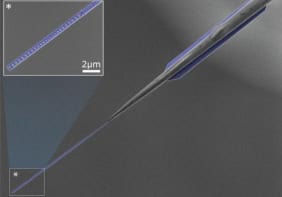
Numerous physicists over the years have claimed they can turn hydrogen into a metal by squeezing it extremely hard – but none so far have managed to persuade sceptical rivals. Now researchers in France reckon they have finally found convincing evidence for the transformation, having built new devices for pressurizing and observing tiny samples of hydrogen. Yet others in the field remain doubtful, arguing that infrared data reported by the French group does not on its own constitute adequate proof – and that what is needed are measurements of conductivity.
Experts have little doubt that hydrogen should become a metal when subject to very high pressures. Theory tells us that pressure frees electrons from the confines of individual atoms or molecules, allowing them to freely propagate through the material. Indeed, many insulators have been observed making the transition – molecular oxygen, for example, was shown about 20 years ago to become a metal at around one million times atmospheric pressure (about 100 GPa). “Indisputably, metal hydrogen should exist,” write Paul Loubeyre, Florent Occelli and Paul Dumas of the French energy agency CEA in a paper recently uploaded to arXiv.
Metallic hydrogen could have many striking properties including being a superconductor at room temperature. Studying its behaviour could also lead to new insights about conditions inside Jupiter and other gas-giant planets, given its predicted abundance there.
Extremely difficult and controversial
But making metallic hydrogen has proven extremely difficult and controversial. Since it was predicted in 1935, researchers have tried to create it in the lab by squeezing tiny samples of hydrogen gas between the tips of two diamonds. These miniature anvils can deliver pressures of hundreds of gigapascals, but the results are often ambiguous. In 2016, two researchers at Harvard University in the US reported making metallic hydrogen at 500 GPa. Others, however, questioned whether such a high pressure was reached by the team.
Loubeyre and colleagues are not newcomers to the search. In 2002 they used visible light to observe changes in a hydrogen sample that they compressed up to 320 GPa. As they raised the pressure, they saw that the electronic bandgap of solid hydrogen dropped proportionally. By extrapolating the line to higher pressure they reckoned it should have reached zero at about 450 GPa. At this point hydrogen would become a metal because its electrons would freely enter the conduction band.
To reach this pressure, the team developed new kind of “toroidal” anvil cell in which samples are squeezed between two tiny flat surfaces surrounded by ring-shaped depressions. This, they say, can generate pressures of up to at least 600 GPa. They also designed and built an infrared microscope that can be deployed together with a cryostat within the intense radiation from a synchrotron source.
We show a first order phase transition near 425 GPa from insulator molecular solid hydrogen to metal hydrogen
Paul Loubeyre, Florent Occelli and Paul Dumas
The team put their toroidal anvil, containing hydrogen at 80 K, and microscope in a beamline at the SOLEIL synchrotron on the outskirts of Paris. At pressures of about 425 GPa they observed that the infrared light that would otherwise pass through the sample was almost completely absorbed. This is proof, they say, that the bandgap was closed. They add that their results closely match predictions made by theorists in 2015. “We show a first order phase transition near 425 GPa from insulator molecular solid hydrogen to metal hydrogen,” they write in their paper.

Show us your metal
Other researchers welcome the latest work but some are not entirely convinced. “I think that the paper contains good evidence about the band gap closure in hydrogen,” says Alexander Goncharov of the Carnegie Institution for Science in Washington. “Some interpretations may be incorrect, and some data could be better, but I generally trust that this is valid.” Nevertheless, he reckons that the evidence isn’t watertight, arguing that with a narrow but non-zero band-gap the hydrogen might have become a very narrow band-gap semiconductor, rather than a metal.
Mikhail Eremets of the Max Planck Institute for Chemistry in Mainz, Germany, agrees, and argues that the reduction of the band gap doesn’t constitute “direct evidence of metallization”. What’s really needed, he says, is a measurement of the hydrogen’s electrical conductivity. He adds that he and his colleagues carried out such a measurement two years ago, showing that hydrogen starts to conduct (like a “semimetal”) at about 360 GPa and that conductivity increases strongly with pressure. They also measured Raman spectra, which determine whether hydrogen is in a molecular state. “Our data could be complimentary to Loubeyre et al’s infrared data” he says, “but [they] completely ignore this work.”
The research is described in a paper on arXiv.



